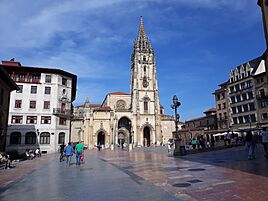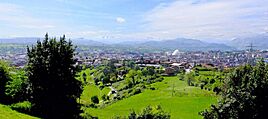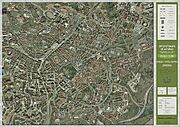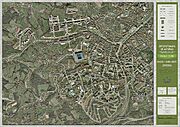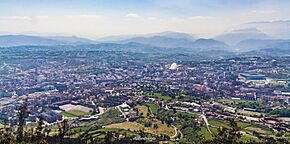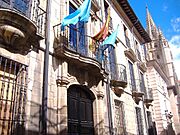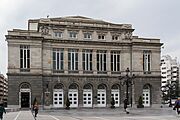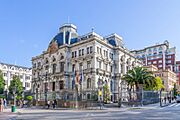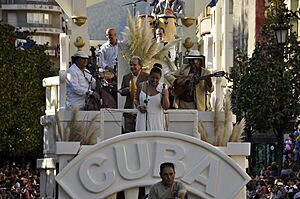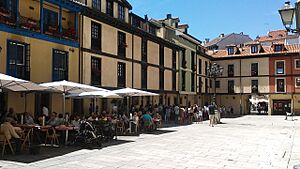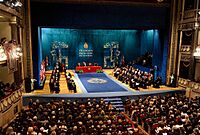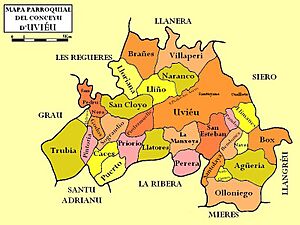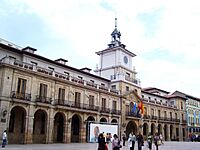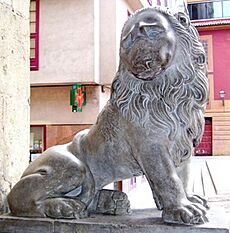Oviedo facts for kids
Quick facts for kids
Oviedo
Uviéu (Asturian)
|
|||
|---|---|---|---|
| Oviedo/Uviéu | |||
|
Campoamor Theatre
Asturian parliament
Fontán Square
View from Naranco mountain
|
|||
|
|||
| Motto(s):
Benemérita, invicta, heroica, buena, muy noble, muy leal
(Meritorious, undefeated, heroic, good, very noble, very loyal) |
|||
| Country | Spain | ||
| Autonomous community | Asturias | ||
| Province | Asturias | ||
| Comarca | Oviedo | ||
| Area | |||
| • Total | 186.65 km2 (72.07 sq mi) | ||
| Elevation | 232 m (761 ft) | ||
| Population
(2018)
|
|||
| • Total | 220,020 | ||
| • Density | 1,178.78/km2 (3,053.04/sq mi) | ||
| Demonym(s) | ovetense in Castilian uvieín/a in Asturian or, colloquially, carbayón |
||
| Time zone | UTC+1 (CET) | ||
| • Summer (DST) | UTC+2 (CEST) | ||
| Postal code |
from 33001 to 33013
|
||
| Official language(s) | Spanish | ||
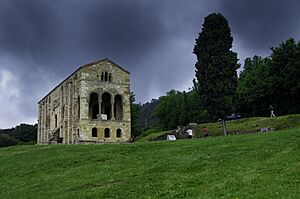

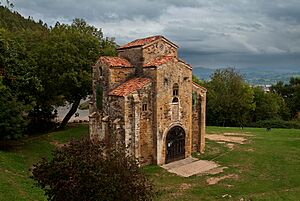
Oviedo (also called Uviéu in Asturian) is the capital city of Asturias, a region in northern Spain. It is the main center for business and government in the area. Oviedo is about 24 kilometers (15 miles) southwest of Gijón and 23 kilometers (14 miles) southeast of Avilés. Both of these cities are on the coast of the Bay of Biscay. Even though Oviedo is not directly on the coast, it's less than 30 kilometers (19 miles) from the ocean. This, combined with its higher elevation (over 300 meters or 980 feet above sea level), gives the city a mild, ocean-influenced climate.
Contents
- Exploring Oviedo's Past
- Oviedo's Location and Landscape
- Economy and Jobs
- Amazing Architecture in Oviedo
- Culture and Arts in Oviedo
- Sports in Oviedo
- Feasts and Traditions
- Oviedo's Climate
- Getting Around Oviedo
- Famous People from Oviedo
- Other Places in the Municipality
- Oviedo's International Connections
- See also
Exploring Oviedo's Past
How Oviedo Began
The Kingdom of Asturias started in 720 AD. This happened when a Visigothic leader named Pelagius fought against the Muslims. At that time, Muslims had taken over most of the Iberian Peninsula (Spain and Portugal). Pelagius's revolt in the northern mountains led to the creation of the Kingdom of Asturias. This kingdom was in a less wealthy part of Spain, so the Muslims mostly left it alone. In 720, the area where Oviedo is now was empty.
It is believed that two monks, Máximo and Fromestano, founded Oviedo in 761 AD. They built a small church dedicated to Saint Vincent. Oviedo was built on a hillside that had no previous Roman or Visigothic settlements.
Early Kings and Challenges
After Pelagius died in 737, Alfonso I (who ruled from 739–757) started a royal family that lasted until 1037. The Asturian Kingdom was often in conflict with the Muslim-controlled areas to the south. In 794, Oviedo was attacked and looted by Caliph Hisham I.
King Alfonso I wanted Oviedo to be like Toledo, which was an important Visigothic city. Even so, Oviedo's buildings looked more like older Roman styles. The churches and buildings in Oviedo were quite impressive, especially since Asturias was not a rich farming area.
Building the Capital City
Oviedo's amazing architecture began with King Fruela I (757–768). He was the first king to really develop the city. He built a palace and a church. Later, King Alfonso II (791–842), known as "The Chaste," made Oviedo the capital. He moved the royal court here from Pravia. He also helped create the Pilgrim's Route to Santiago de Compostela, which was a very important event for Oviedo.
Alfonso II built the Cathedral of San Salvador and a royal palace, which became the heart of Oviedo. He also built the San Julián de los Prados church, which is one of the best-preserved Asturian churches. King Ramiro I (842–850) continued this building trend. He built two more important buildings: the Church Santa Maria del Naranco and San Miguel de Lillo. The Church Santa Maria de Naranco was probably Ramiro I's palace first, then it became a church.
Later Kings and Changes
King Ordoño I (850–866) followed Ramiro I. He was the first king to try to expand the kingdom south into Arab lands. After Ordoño I died, his son Alfonso III (866–910) became king. He was only thirteen.
Alfonso III also contributed to building. In 882, the body of a Christian martyr named Eulogius was sent to Oviedo as a diplomatic gift. In 908, Alfonso III ordered a special gold and jewel-covered cross to hold the wooden cross that Pelagius I supposedly carried at the Battle of Covadonga. This "Cross of Victory" is kept in the Camara Sancta in the Oviedo Cathedral.
Towards the end of Alfonso III's rule, his sons overthrew him. He died in Zamora, and his body was brought to Oviedo for burial.
Oviedo in the Middle Ages
After Alfonso III died, the royal court moved to León. This meant kings spent less time in Oviedo. However, Oviedo remained important because of the holy items kept in its cathedral and the pilgrims who visited on their way to Santiago de Compostela.
During the 12th century, Bishop Pelayo of Oviedo created many fake royal documents. He did this to try and make Oviedo's church more independent and to promote Oviedo as a pilgrimage site.
From the 12th to the 16th centuries, Oviedo grew as a medieval city. City walls were built, and a big fire happened on Christmas Eve in 1521. An aqueduct called Los Pilares was built in the 16th century to bring water to the city.
Modern Oviedo Develops
The University of Oviedo was founded in the early 17th century. This helped Oviedo grow and expand. In the 18th century, rich families built grand palaces. In the 19th century, industries grew, and new areas like Uría Street developed. In the 20th century, Oviedo became a major center for government and business.
In October 1934, there was a workers' strike in Asturias, mostly by miners. They took control of Oviedo after heavy fighting. The Spanish Army, led by General Francisco Franco, eventually defeated the rebels. The cathedral was badly damaged during this time.
The Siege of Oviedo in 1936 was a key event in the Spanish Civil War. The army in Oviedo supported the Nationalist side and held out against a three-month siege by Republican forces until they were rescued in 1937.
Oviedo's Location and Landscape
Oviedo is in the middle of Asturias, between the Nalón River and Nora River. To the north are Las Regueras and Llanera. To the south are Mieres and Ribera de Arriba. To the east are Siero and Langreo, and to the west are Grado and Santo Adriano. The city's elevation ranges from 80 to 709 meters (260 to 2,326 feet) above sea level. Monte Naranco to the north and the Sierra del Aramo to the south protect the city from strong winds. The city center itself has many hills.
Economy and Jobs
Oviedo's economy mostly relies on the service sector. This means there are many offices and jobs in public administration, as Oviedo is the government center of the region. While manufacturing is important in this part of Spain, it's not as big in Oviedo itself. Instead, it's more common in nearby towns like Siero and Llanera.
Amazing Architecture in Oviedo
Oviedo has a very rich history of architecture. Many buildings date back to the early medieval period. A lot of building projects happened during the reigns of King Alfonso II (791-842) and King Ramiro I (842-850).
Important Historical Buildings
- Cathedral of San Salvador: This cathedral was built starting in 1388, on top of an older church from the 8th century. The south tower was finished in 1556, but the north tower was never completed.
- Cámara Santa de Oviedo: Built around 802, this special room is inside the Cathedral. It is a UNESCO World Heritage Site. It holds many Christian treasures, including the Arca Santa chest and the Sudarium of Oviedo. It also once held the famous gold and jeweled Cross of Victory, made for King Alfonso III.
- Santa María del Naranco Hall: This building from the 9th century was part of a palace complex for King Ramiro I. It was later turned into a church.
- San Miguel de Lillo: A small church also from the 9th century.
- Basilica of San Julián de los Prados: King Alfonso II built this church, and it's one of the best-preserved Asturian churches. It has beautiful fresco paintings.
- La Foncalada: This fountain from the 9th century is the only remaining Pre-Romanesque civil building in all of Europe.
- University of Oviedo: Founded in 1574 and opened in 1608. It was funded by Archbishop Fernando Valdés Salas.
- Town Hall (Casa Consistorial): This building dates back to 1662.
- La Balesquida Chapel: From the 13th century, this chapel is linked to Oviedo's tailors' guild. It has been restored many times.
- House of the Llanes: Built in the 18th century, it has the best Baroque style front in Asturias.
- Deán Payarinos' House: A 20th-century building in the Beaux Arts style. Today, it's home to the Eduardo Martínez Torner Conservatory.
- Monastery of San Vicente: This monastery from the 8th century now houses the Archaeological Museum of Asturias.
- Convent Church of Santo Domingo, Oviedo: Built in the 16th century, it was rebuilt after a fire in 1934 and the Civil War.
- El Fontán Market: This market from the 17th-18th centuries was rebuilt in 1998.
- Casas del Cuitu: An early 20th-century apartment building in the Art Nouveau style.
- Palacio de Congresos de Oviedo: A modern building designed by Santiago Calatrava.
- Church of San Tirso: Only the east end of this church dates back to Alfonso II's time. The rest was built in the 14th century.
- Camposagrado Palace: Built between 1728 and 1744, it mixes Baroque and Neo-classical styles. It is now home to the Regional Court of Asturias.
Famous Plazas and Squares
- Plaza de la Escandalera: A main square in the city center.
- Plaza del Fontán: Located in the old part of the city, it has been a marketplace for centuries.
- Corrada del Obispo
- Plaza Porlier: Found near the cathedral in the downtown area.
Culture and Arts in Oviedo
Oviedo has inspired many writers and artists. For example, the city of Vetusta in Leopoldo Alas's novel La Regenta is based on Oviedo. The city was also featured in Woody Allen's movie Vicky Cristina Barcelona.
Museums to Visit
- Archaeological Museum of Asturias
- Museum of Fine Arts of Asturias
- Camara Santa (inside the Cathedral, holding the Arca Santa and Sudarium of Oviedo)
- Diocesan Museum
- Tabularium Artis Asturiensis
- Center for the reception and understanding of Preromanesque Art
Other Cultural Places
- Campoamor Theatre: A famous opera house.
- Filarmónica Theatre
- Palacio de Congresos de Oviedo
- Prince Felipe Auditorium
Cultural Events and Institutions
The Orquesta Sinfonica del Principado de Asturias is the main orchestra of the region. It performs classical music with famous soloists and conductors. It is based in Oviedo but also performs in Gijón and Avilés.
Oviedo also hosts the yearly Princess of Asturias Awards. This important event takes place at the Campoamor Theatre and honors international achievements in eight different areas. Past winners include Nelson Mandela and Al Gore.
The Oviedo University attracts many students and scholars from around the world.
The city is also known for the sudarium of Oviedo, a religious cloth that has been kept there since the 9th century.
Sports in Oviedo
Famous Athletes
The most famous athlete from Oviedo is Fernando Alonso. He is a Formula One world champion from 2005 and 2006. He is Spain's only Formula One title winner. He has raced for many teams like Renault, Ferrari, and Aston Martin. His official museum and a karting circuit he designed are located near Oviedo.
Local Sports Teams
- Real Oviedo: A football team that plays in Spain's second division.
- Real Oviedo Rugby: A rugby union team.
- Oviedo CB: A basketball team.
- Balonmano Base Oviedo: A handball team.
- Oviedo Booling: A roller hockey team.
- Real Oviedo Femenino: A women's football team.
Yearly Sports Events
- International Showjumping Competition
- City of Oviedo Horse Show
- City of Oviedo San Silvestre (a running race)
- Outdoor Sports Climbing
- Vuelta a España (Cycling race)
- Vuelta a Asturias (Cycling race)
- Ascent of Naranco (Cycling race)
- City of Oviedo Mountain Bike Open
- City of Oviedo Cycle Criterium
- Base Hockey International Tournament
- Prince of Asturias International Rally
- National Auto-Cross Championship
- International Hurdles Competition
- International Chess Open
- Boxing Nights
- Ascension Bowls Tournament
- San Mateo Bowls Tournament
- Open de España (Disc Golf)
Feasts and Traditions
Festive Calendar
- Cabalgata de los Reyes Magos de Oriente: This is the traditional Three Kings' Day parade. The Three Wise Men and their helpers parade through the city streets. They end at the Cathedral Square, where they offer gifts to the Child Jesus.
- L'Antroxu (Carnival)
- The Sudarium of Oviedo: This religious cloth is shown to the public three times a year: on Good Friday, September 14th (Feast of the Triumph of the Cross), and September 21st.
- The Feast of the Ascension
- La Foguera de San Xuan (Saint John's Bonfire)
- La Balesquida or Martes del Bollu or Martes del campo: This is a public holiday in mid-May. People have picnics in the parks.
- The Feast of San Mateo: A popular week-long festival with street food, music, concerts, and the Día de América en Asturias parade.
- El Desarme (Disarmament's Day): This day celebrates a clever victory by the locals over an army during the First Carlist War in the 1830s.
Typical Foods of Oviedo
- Fabada : A hearty bean stew with pork and other meats.
- Callos : A dish made with tripe.
- Carne gobernada : Chunks of meat cooked with onion, garlic, and white wine sauce.
- Chorizo a la sidra : Chorizo sausage cooked in cider.
- Paxarines : Figures made from breadcrumbs and egg, colored with saffron.
- Carbayones : Oviedo's special almond pastry.
- Sidra : Cider, a traditional Asturian drink made from fermented apples.
- Arroz con leche : Similar to rice pudding.
- Frixuelos : Similar to a crêpe.
Oviedo's Climate
Oviedo has a mild ocean climate. It's similar to the nearby city of Gijón, but with slightly bigger temperature changes because it's higher up and further inland. August is the warmest month, with an average high of 23.3°C (73.9°F). Winters are much milder than in central Spain, but summers are not as hot. There's a little less rain in summer, but it's still a wet region.
| Climate data for Oviedo, altitude 336 m (1,102 ft) (1991–2020) | |||||||||||||
|---|---|---|---|---|---|---|---|---|---|---|---|---|---|
| Month | Jan | Feb | Mar | Apr | May | Jun | Jul | Aug | Sep | Oct | Nov | Dec | Year |
| Record high °C (°F) | 23.4 (74.1) |
24.6 (76.3) |
28.2 (82.8) |
31.5 (88.7) |
33.2 (91.8) |
35.5 (95.9) |
39.1 (102.4) |
35.6 (96.1) |
36.4 (97.5) |
31.7 (89.1) |
26.6 (79.9) |
23.0 (73.4) |
39.1 (102.4) |
| Mean maximum °C (°F) | 18.8 (65.8) |
19.7 (67.5) |
23.1 (73.6) |
24.2 (75.6) |
27.3 (81.1) |
29.7 (85.5) |
29.6 (85.3) |
31.1 (88.0) |
28.4 (83.1) |
25.7 (78.3) |
21.6 (70.9) |
18.8 (65.8) |
32.6 (90.7) |
| Mean daily maximum °C (°F) | 12.0 (53.6) |
12.8 (55.0) |
15.1 (59.2) |
16.2 (61.2) |
18.7 (65.7) |
21.2 (70.2) |
23.0 (73.4) |
23.7 (74.7) |
22.0 (71.6) |
19.0 (66.2) |
14.4 (57.9) |
12.5 (54.5) |
17.6 (63.7) |
| Daily mean °C (°F) | 8.5 (47.3) |
8.8 (47.8) |
10.5 (50.9) |
11.8 (53.2) |
14.3 (57.7) |
17.0 (62.6) |
18.9 (66.0) |
19.4 (66.9) |
17.7 (63.9) |
14.9 (58.8) |
10.9 (51.6) |
9.1 (48.4) |
13.5 (56.3) |
| Mean daily minimum °C (°F) | 4.9 (40.8) |
4.9 (40.8) |
6.3 (43.3) |
7.4 (45.3) |
9.9 (49.8) |
12.7 (54.9) |
14.7 (58.5) |
15.1 (59.2) |
13.3 (55.9) |
10.7 (51.3) |
7.4 (45.3) |
5.6 (42.1) |
9.4 (48.9) |
| Mean minimum °C (°F) | 0.1 (32.2) |
0.1 (32.2) |
1.2 (34.2) |
2.5 (36.5) |
5.1 (41.2) |
8.4 (47.1) |
10.5 (50.9) |
11.0 (51.8) |
8.8 (47.8) |
5.6 (42.1) |
2.4 (36.3) |
0.1 (32.2) |
−1.6 (29.1) |
| Record low °C (°F) | −6.0 (21.2) |
−3.8 (25.2) |
−3.6 (25.5) |
−0.5 (31.1) |
1.6 (34.9) |
5.6 (42.1) |
7.4 (45.3) |
8.6 (47.5) |
5.2 (41.4) |
2.4 (36.3) |
−4.2 (24.4) |
−3.6 (25.5) |
−6.0 (21.2) |
| Average precipitation mm (inches) | 103.6 (4.08) |
93.2 (3.67) |
90.4 (3.56) |
98.4 (3.87) |
82.5 (3.25) |
63.2 (2.49) |
45.3 (1.78) |
59.3 (2.33) |
69.4 (2.73) |
106.5 (4.19) |
135.9 (5.35) |
108.2 (4.26) |
1,055.9 (41.56) |
| Average precipitation days (≥ 1 mm) | 12.4 | 10.4 | 11.4 | 12.3 | 12.0 | 9.4 | 7.6 | 8.0 | 8.3 | 11.7 | 13.8 | 11.9 | 129.2 |
| Mean monthly sunshine hours | 113 | 125 | 160 | 166 | 178 | 170 | 179 | 185 | 175 | 147 | 108 | 109 | 1,815 |
| Source: Météo Climat Infoclimat | |||||||||||||
| Climate data for Oviedo, altitude 336 m (1,102 ft) (1981–2010) | |||||||||||||
|---|---|---|---|---|---|---|---|---|---|---|---|---|---|
| Month | Jan | Feb | Mar | Apr | May | Jun | Jul | Aug | Sep | Oct | Nov | Dec | Year |
| Record high °C (°F) | 23.4 (74.1) |
24.6 (76.3) |
28.2 (82.8) |
31.5 (88.7) |
33.2 (91.8) |
35.5 (95.9) |
36.8 (98.2) |
35.6 (96.1) |
36.4 (97.5) |
31.7 (89.1) |
26.6 (79.9) |
23.0 (73.4) |
36.8 (98.2) |
| Mean daily maximum °C (°F) | 12.0 (53.6) |
12.7 (54.9) |
14.9 (58.8) |
15.7 (60.3) |
18.2 (64.8) |
20.9 (69.6) |
22.8 (73.0) |
23.3 (73.9) |
22.1 (71.8) |
18.7 (65.7) |
14.6 (58.3) |
12.4 (54.3) |
17.4 (63.3) |
| Daily mean °C (°F) | 8.3 (46.9) |
8.7 (47.7) |
10.5 (50.9) |
11.3 (52.3) |
13.9 (57.0) |
16.7 (62.1) |
18.7 (65.7) |
19.1 (66.4) |
17.6 (63.7) |
14.6 (58.3) |
10.9 (51.6) |
8.9 (48.0) |
13.3 (55.9) |
| Mean daily minimum °C (°F) | 4.6 (40.3) |
4.7 (40.5) |
6.1 (43.0) |
6.8 (44.2) |
9.5 (49.1) |
12.4 (54.3) |
14.5 (58.1) |
14.8 (58.6) |
13.1 (55.6) |
10.4 (50.7) |
7.2 (45.0) |
5.3 (41.5) |
9.1 (48.4) |
| Record low °C (°F) | −6.0 (21.2) |
−3.8 (25.2) |
−3.6 (25.5) |
−0.5 (31.1) |
1.6 (34.9) |
5.6 (42.1) |
7.4 (45.3) |
8.6 (47.5) |
5.2 (41.4) |
2.4 (36.3) |
−4.2 (24.4) |
−3.6 (25.5) |
−6.0 (21.2) |
| Average precipitation mm (inches) | 84 (3.3) |
81 (3.2) |
78 (3.1) |
100 (3.9) |
82 (3.2) |
57 (2.2) |
45 (1.8) |
56 (2.2) |
66 (2.6) |
99 (3.9) |
115 (4.5) |
99 (3.9) |
962 (37.8) |
| Average precipitation days (≥ 1 mm) | 11 | 10 | 10 | 12 | 12 | 8 | 7 | 8 | 8 | 11 | 12 | 12 | 122 |
| Average relative humidity (%) | 76 | 75 | 74 | 76 | 78 | 79 | 79 | 80 | 78 | 79 | 79 | 77 | 78 |
| Mean monthly sunshine hours | 115 | 122 | 153 | 161 | 167 | 167 | 177 | 176 | 167 | 138 | 109 | 105 | 1,756 |
| Source: Agencia Estatal de Meteorología | |||||||||||||
Getting Around Oviedo
Air Travel
Oviedo is served by Asturias Airport, which is about 48 kilometers (30 miles) from the city center. You can reach the airport by motorway or by bus.
Public Transportation
Oviedo has 15 bus lines and a special "owl" (night) bus line. The night buses run on Saturdays, Sundays, and before public holidays (except Christmas Eve and Christmas Day). Two newer lines connect rural areas of Oviedo and run on weekdays.
Train Services
The Oviedo railway station offers many train services. These include long-distance, middle-distance, and local (cercanías) trains run by Renfe. There are also narrow-gauge train lines run by Renfe Feve. Within the Oviedo area, there are other train stations in places like La Corredoria, Llamaquique, and Trubia.
Historical Transport
- Mining Railway: From 1880 to 1916, a narrow-gauge railway called the Oviedo-Villapérez mining railway carried iron ore from mines to Oviedo. It was about 7 kilometers (4 miles) long.
- Tramway: Oviedo used to have a tramway system from 1922 to 1956.
Famous People from Oviedo
Many notable people were born in or have connections to Oviedo:
- HM Queen Letizia of Spain: The wife of the Spanish King Felipe VI.
- Leopoldo Alas Clarín: A 19th-century novelist and literary critic.
- Fernando Alonso: A racing driver and Formula One World Champion in 2005 and 2006. He also won the 24 Hours of Le Mans twice.
- Galo Blanco: A professional tennis player and coach.
- Enrique Castro Quini: A retired football player, considered one of Spain's best strikers.
- Sabino Fernández-Campo: Head of the Spanish Royal House from 1990 to 1993.
- Carmen Domínguez: A glaciologist (born 1969).
- Antonio Gamoneda: Winner of the 2006 Cervantes Prize for literature.
- Ángel González: A poet.
- Sid Lowe: A well-known international football journalist.
- Juan Mata: A footballer who played for Manchester United. He won the World Cup and European Championship with Spain.
- Melendi: A popular singer.
- Michu: A former footballer for Swansea City.
- Ramón Pérez de Ayala: A writer.
- Carmen Polo: The wife of Spain's dictator Francisco Franco.
- Indalecio Prieto: A socialist politician and leader of the Spanish Socialist Workers' Party.
- Ángela Salvadores: A basketball player.
- Samuel Sánchez: A cyclist who won the 2008 Olympic Road Race.
- Jorge Suárez Carbajal: An Asturian bagpiper.
- Tioda: A 9th-century architect who designed several of Oviedo's early buildings.
- Tino Casal: A singer, songwriter, and producer from Tudela Veguín, in the Oviedo municipality.
- El Sueño de Morfeo: A musical group.
Other Places in the Municipality
The municipality of Oviedo includes several other towns and areas:
- Trubia
- Colloto (part of this town is also in Siero)
- San Claudio
- San Esteban de les Cruces
- Latores
- Olloniego
Oviedo's International Connections
Oviedo is twinned with many cities around the world. This means they have special friendly relationships. Oviedo, Florida (U.S.) has been twinned with Oviedo, Spain, since 1877.
Here are some of Oviedo's sister cities:
 Valparaíso, Chile, since 1976
Valparaíso, Chile, since 1976 Bochum, Germany, since 1979
Bochum, Germany, since 1979 Buenos Aires, Argentina, since 1983
Buenos Aires, Argentina, since 1983 Veracruz, Mexico, since 1983
Veracruz, Mexico, since 1983 Clermont-Ferrand, France, since 1988
Clermont-Ferrand, France, since 1988 Tampa, Florida (U.S.) since 1991
Tampa, Florida (U.S.) since 1991 Santiago de Compostela, Spain, since 1993
Santiago de Compostela, Spain, since 1993 Santa Clara, Cuba, since 1995
Santa Clara, Cuba, since 1995 Jersey City, New Jersey (U.S.), since 1998
Jersey City, New Jersey (U.S.), since 1998 Holon, Israel, since 1999
Holon, Israel, since 1999 Zamora, Spain, since 2001
Zamora, Spain, since 2001 Torrevieja, Spain, since 2004
Torrevieja, Spain, since 2004 Hangzhou, China, since 2006
Hangzhou, China, since 2006 Valencia de Don Juan, Spain, since 2006
Valencia de Don Juan, Spain, since 2006 Viseu, Portugal, since 2007
Viseu, Portugal, since 2007 Maranello, Italy, since 2010
Maranello, Italy, since 2010
See also
 In Spanish: Oviedo para niños
In Spanish: Oviedo para niños


